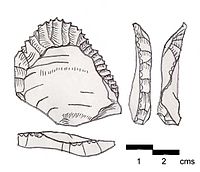 | |
| Geographical range | Levant |
|---|---|
| Period | Upper Paleolithic |
| Dates | c. 46,000 – c. 42,000 BP |
| Preceded by | Aterian, Emiran, Bohunician |
| Followed by | Levantine Aurignacian Châtelperronian Aurignacian (Europe) |
The Ahmarian culture was a Paleolithic archeological industry in the Levant dated at 46,000–42,000 years before present (BP) and thought to be related to Levantine Emiran and younger European Aurignacian cultures.
The word "Ahmarian" was adopted from the archaeological site of Erq el-Ahmar (also written Erk el Ahmar), West Bank, Palestine, a rockshelter in the Judean Desert in the northern Dead Sea Rift. It was explored and excavated by French Prehistorian René Neuville in 1951. The "Ahmarian" category had only been recognized since the 1980s, and was previously designated as "Phase II Upper Paleolithic" or "Ksar Akil Phase B".
Ahmarian period
The Ahmarian period together with the Emiran period, both from the Levant, are among the first periods of the Upper Paleolithic, corresponding to the first stages of the expansion of Homo sapiens out of Africa. From this stage, the first modern humans migrated to Europe to form the beginning of the European Upper Paleolithic, including the Aurignacian culture, where they become known as the Cro-Magnons.
The European Bohunician culture, probably linked to the Emiran and Ahmarian, may slightly predate the Ahmarian at 48,000 BP. There is also a claim that it is roughly contemporary with the Aurignacian and the Gravettian cultures of Europe, all emerging prior to the Atlitian, which was also contemporary with the Solutrean and Magdalenian cultures of Western Europe.
Ahmarian technology, which included the complex of blade/bladelet-knapping techniques is also linked to the tools used by the hunter-gatherers of southwestern Asia.
Late Ahmarian is called Masraqan.
Technology
Ahmarian blades are usually elongated with some curves. The Levallois technique is still in use, but only sparsely, thereby making Ahmarian the first fully Upper Paleolithic period.
Ahmarian assemblages can be found throughout the Levant, including Syria, Lebanon, Israel, Palestine, and Jordan. The Lagaman industry in the Sinai can be considered as derivative to the Ahmarian culture.
"Levantine Aurignacian", from the Levant, is a type of blade technology very similar to the European Aurignacian, immediately following chronologically the Emiran and Early Ahmarian in the same area of the Near East, and closely related to them.
-
 Flint Knives, Ahmarian Culture, Nahal Boqer, 47,000-40,000 BP. Israel Museum.
Flint Knives, Ahmarian Culture, Nahal Boqer, 47,000-40,000 BP. Israel Museum.
-
 Stone core for making fine blades, Boqer Tachtit, Negev, Israel, circa 40,000 BP.
Stone core for making fine blades, Boqer Tachtit, Negev, Israel, circa 40,000 BP.
-
 El-Wad points are typical of the Ahmarian culture.
El-Wad points are typical of the Ahmarian culture.
-
 Ksar Akil flake made by Levallois technique. Found on the surface at Ksar Akil, Lebanon. Another point type typical of the Ahmarian culture (Northern Facies).
Ksar Akil flake made by Levallois technique. Found on the surface at Ksar Akil, Lebanon. Another point type typical of the Ahmarian culture (Northern Facies).
-
Entrance to el-Wad Cave, an important Ahmarian site
-
 Inside of el-Wad Cave.
Inside of el-Wad Cave.
Ahmarian sites
| The Paleolithic |
|---|
| ↑ Pliocene (before Homo) |
|
Lower Paleolithic (c. 3.3 Ma – 300 ka) |
|
Middle Paleolithic (c. 300–50 ka)
|
|
Upper Paleolithic (c. 50–12 ka)
|
| ↓ Mesolithic |
- Erq el-Ahmar (type site)
- Manot Cave
- Boker Tachtit
- Nahal Boqer
- El-Wad
- Ksar Akil (Ahmarian Northern Facies, Lebanon)
References
- "Archaeologists carbon dated a cave in Israel to reveal details about the two first modern human cultures". Newsweek. 28 December 2017.
- Kadowaki, Seiji; Omori, Takayuki; Nishiaki, Yoshihiro (2015). "Variability in Early Ahmarian lithic technology and its implications for the model of a Levantine origin of the Protoaurignacian". Journal of Human Evolution. 82: 67–87. doi:10.1016/j.jhevol.2015.02.017. PMID 25924809.
- Goring-Morris, Nigel; Belfer-Cohen, Anna (2018). "The Ahmarian in the Context of the Earlier Upper Palaeolithic in the Near East". The Middle and Upper Paleolithic Archeology of the Levant and Beyond. pp. 87–104. doi:10.1007/978-981-10-6826-3_7. ISBN 978-981-10-6825-6.
- Gilead, Isaac (1991). "The Upper Paleolithic period in the Levant". Journal of World Prehistory. 5 (2): 105–154. doi:10.1007/BF00974677. S2CID 163984548.
- Akazawa, Takeru; Nishiaki, Yoshihiro; Aoki, Kenichi (16 December 2013). Dynamics of Learning in Neanderthals and Modern Humans Volume 1: Cultural Perspectives. Springer Science & Business Media. ISBN 9784431545118 – via Google Books.
- Nishiaki, Yoshihiro; Akazawa, Takeru (6 December 2017). The Middle and Upper Paleolithic Archeology of the Levant and Beyond. Springer. ISBN 9789811068263.
- Marder, Ofer; Yeshurun, Reuven; Smithline, Howard; Ackermann, Oren; Mayer, Daniella E. Bar-Yosef; Belfer-Cohen, Anna; Grosman, Leore; Hershkovitz, Israel; Klein, Noa, "Hof Shahaf", Natufian Foragers in the Levant, Berghahn Books, pp. 505–526, doi:10.2307/j.ctv8bt33h.35, retrieved 2023-12-19
- ^ Shea, John J. (2013). Stone Tools in the Paleolithic and Neolithic Near East: A Guide. Cambridge University Press. pp. 152–153. ISBN 9781107006980.
- Shea, John J. (2013). Stone Tools in the Paleolithic and Neolithic Near East: A Guide. Cambridge University Press. p. 154. ISBN 9781107006980.
- Shea, John. (PDF) Selected Figures from Chapter 5. Upper Paleolithic | John Shea - Academia.edu.
- Klein, Richard G. (2009). The Human Career: Human Biological and Cultural Origins. University of Chicago Press. p. 610. ISBN 9780226027524.
- Hoffecker, J. F (2009). "The spread of modern humans in Europe". Proceedings of the National Academy of Sciences. 106 (38): 16040–16045. doi:10.1073/pnas.0903446106. PMC 2752585. PMID 19571003.
- Avi-Yonah, Michael (2001). A History of Israel and the Holy Land. New York: Continuum. p. 20. ISBN 0826413226.
- De Laet, S.J.; Dani, A.H.; Lorenzo, J.L.; Nunoo, R.B. (1994). History of Humanity: Prehistory and the beginnings of civilization. London: Routledge. pp. 244. ISBN 0415093058.
- Belfer-Cohen, Anna; Goring-Morris, Adrian (2012). "The earlier Upper Palaeolithic: a View from The Southern Levant". In Otte, M.; Shidrang, S.; Flas, D. (eds.). The Aurignacian from the Yafteh Cave and its context (2005–2008 excavations). pp. 127–136 – via ResearchGate.